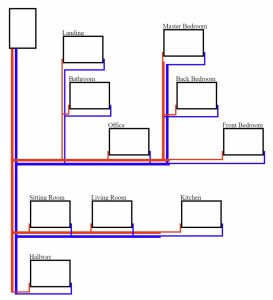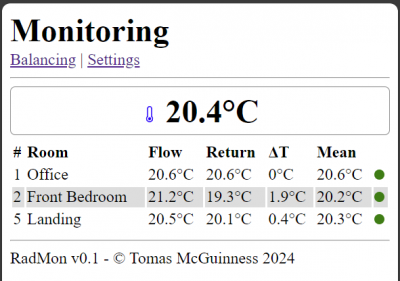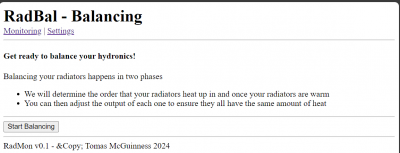Migrating from boiler to heap-pump; balancing radiators and UFH
Hi,
My name is Tom and I started my renewables journey back in 2021 when I moved from London to Solihull in the West Midlands.
We bought a very nice four bedroom house, built in 1958 and set about renovating it. I didn't know much about renewables back then, only that I wanted to get a heat pump. Unfortunately, due to time pressure to get moved in and an inability to find anyone to do a heat pump on short notice, I ended up with a stupidly big gas boiler!
And that boiler started me on a journey to understand central heating as I tried to get my gas bills under control. Since moving in, I've done a lot of DIY, insulating the ground floors of my house, updating the loft insulation and sealing up gaps etc. where I can. I also had cavity wall insulation added.
I had solar panels and a home battery adding in 2023 and that's been working very well.
I've also been tinkering with my heating, adjusting my boiler's settings to try and compensate for the fact it's about 4 times too large! As I'm a smart home enthusiast, I'm continually adding monitoring and instrumentation to help me understand exactly what's going on, even going so far as to try building my own sensors to monitor my radiators. I hope of the heat distribution throughout my house and to get my system as balanced as I can.
A heat pump is next on the cards, but I want to complete more fabric upgrades first like new front door and potentially new windows. Heat loss is something I'd like to get a handle on and I'm trying to work out whether my existing rads and pipework will take the upgrade without too much fuss.
I started creating videos on YouTube last year (Tomas McGuinness - YouTube) and I try to cover most of what I'm doing at home!
Hopefully I'll be able to contribute to the community here!
Owner of a ridiculously oversized 35kW boiler and trying to make it as efficient as possible. 4.8kW solar PV with 5.4kWh storage. EV driver.
Follow my journey at https://www.youtube.com/@tomasmcguinness
Next big project is a heat pump!
Thanks for the details @tomasmcguinness
and you earn a virtual pint for including a graphic within your very first post here on the forum 🍺
Can we assume that
- the heating elements are all radiators?
- the gas boiler is a combi (with no storage tank)?
Save energy... recycle electrons!
Hi,
Only radiators on the graphic for now, but I have 300m of UFH in my new kitchen extension (three loops of 100m each). Once I get the monitoring sorted on my radiators, I'll be looking at how best to monitor that.
Been going through a long learning curve, but finally have something that's working and within a few tenths of a degree from my Testo clamps. I have another seven sensors to finish 🙂
In terms of my boiler, I have a system boiler with a 210L Mixergy hot water tank. It's a Greenstar 8000. 35kW.
Radiators and UFH each have their own zone valves. System is poorly balanced as UFH causes upstairs rads to drop way down in temp 🙁
Owner of a ridiculously oversized 35kW boiler and trying to make it as efficient as possible. 4.8kW solar PV with 5.4kWh storage. EV driver.
Follow my journey at https://www.youtube.com/@tomasmcguinness
Next big project is a heat pump!
I could make lots of observations on what you've just stated @tomasmcguinness !
I have a gas system boiler and a 300-litre Thermal Store supplying DHW and UFH.
The boiler circuit also supplies two small radiators and two towel rails.
Balancing is highly desirable!
This might be the moment for you to start your own Topic, so that others can comment technically, but without burdening this Welcome Topic.
Choose a title which others are likely to be attracted to in future:
"Migrating from boiler to heap-pump; balancing radiators and UFH" is good because it covers all the likely issues,
whereas "Problems balancing rads with Mixergy" only describes half the problem, infers that failings are due to that particular storage tank, and sounds negative. Ugh!
Here we prefer discussing solutions.... the positive side of the coin 🙂
Please tag me (insert my Forum ID) within any such new topic if you want me to find it!
Save energy... recycle electrons!
@tomasmcguinness I, too, am getting to grips with a large boiler. Do you mind if I DM to compare notes ? (Or take up @transparent's suggestion)
@ianmk13, please let's keep the conversation, questions and discussion public so that others can learn from this.
Get a copy of The Ultimate Guide to Heat Pumps
Subscribe and follow our YouTube channel!
We're soon to trial flow-settable rad valve insets, and in-line valves from IMI and Giacomini on an installation we supplied the heat pump to in Devon.
In theory instead of measuring dTs and manually tweaking each rad you should just be able to calculate the flow rate desired to each rad, then set and forget. The installer already uses these flow settable insets on heating manifolds to good effect so I'm hopeful. Possible issues for us to look out for may be pressure-drop and noise.
We need to get remote COP monitoring up and running on the pump first, measure efficiency, then make the system changes, so we won't have instant results, but perhaps I can post an update when we do.
Planning your dream house? Book a simple one-to-one consultation to get you on a good path - here.
@ianmk13 Hi - happy to share what I've learned and what I've tried! Create a new topic and I'll get involved!
Owner of a ridiculously oversized 35kW boiler and trying to make it as efficient as possible. 4.8kW solar PV with 5.4kWh storage. EV driver.
Follow my journey at https://www.youtube.com/@tomasmcguinness
Next big project is a heat pump!
As I said here almost a couple of months ago ( https://renewableheatinghub.co.uk/forums/postid/24798), I hoped to start this thread when I have the time. I'm still pressed for time, largely because around that time I took my first steps into Home Assistant (the hard way, running in a virtual environment on a PC), and Espressif Microcontrollers (ESP32's). As a retired hardware engineer having worked on a broad range of technologies, I hadn't had much software involvement for several decades other than dabbling in Visual Basic and macros, so python, C++, JSON and anything else with curly brackets is new to me. I'm also spending considerable time in trying to get a PV and battery installation project on the go.
I alighted on this forum some time last year when deciding that I should educate myself on ASHPs. At my last boiler service, I was advised that my boiler is ageing prematurely (it was installed by the previous home owner around 10 years ago). I quickly learned that a heat loss survey was a good place to start. I began with an MCS spreadsheet and I also commissioned a remote desk-based report on potential heating options from an online source. This was not overly expensive and, on balance, I think it was good value, if only for the insight and educational value. I also decided to do my own heat loss estimates from scratch, taking into account my own detailed knowledge of the various construction methods used on my unconventional property. I concluded that 11-12kW was around the correct figure on paper. A good 6-9 months on, I should probably revisit those figures and my radiator analysis for low temperature operation. I also need to look closely at the fluid thermodynamics, which I last had dealings with at university approaching 50 years ago.
Since I have several years of half-hourly smart meter data and data from a personal weather station, I was able to create a scatter-graph of degree-days and kWh gas consumption (I actually used much higher resolution data - degree-hours - but it was difficult to see the wood for the trees). Excel came to the rescue with a 'best fit' analysis and I was able to determine the energy required for DHW and that required for space heating on those few really cold days.
My present boiler is a basic 'Heat Only' boiler - A BG Potterton Precision rated in excess of 30kW. The only user control is a Reset button. The house is now over 30 years old and most of the TRVs need unseizing every November. The boiler was set at its mid-setting (3 out of 5) and a 'behind the covers' uncalibrated water temperature setting was probably set somewhere over 70degC. At the beginning of this heating season, I set the boiler to its lowest output setting of 1 (around 12kW). With my new-found skills, I built a simple wi-fi device with two temperature probes and have now been logging the flow and return temperatures for over a month. During the recent cold snap, the house kept warm although I do not now set-back overnight. Before my wife and I retired, I discovered that the thermal inertia of the property was such that it took a long time for the house to heat up from cold. I would imagine that with all the data I have now, it should be possible to create a thermal model of some sort.
I really don't know how the Potterton boiler works. It appears to operate open-loop. Other than having an overheat switch, water flow switch and fan airflow switch, there is only a flow temperature sensor. As I am considering the viability of replacing the boiler with an ASHP, common advice is to reduce the flow temperature. I had previously tried to monitor the temperatures with the cheap LCD thermometers but found these to be both inconvenient and inaccurate (perhaps they would have been better with some thermal paste). Now I have a decent monitoring arrangement, during the recent cold spell I was able to adjust the Flow temperature to just under 70degC with the Return temperature comfortably in the 'condensing' region. I have actually been using a Drayton wireless thermostat recently. The issue with this is that it cycles the boiler every 10 minutes. If I remove the Drayton controller (i.e. configure the temperature set point very high) the boiler seems to cycle somewhat randomly, occasionally ramps up to 70degC and turns off. I suspect it is not modulating at all. If it's mild out, he house becomes a bit too warm.
We had a kitchen/diner refurbishment last year with a small extension added. In the process, we had 2 large column radiators installed (which will probably be inadequate for ASHP use, but that's another story). Being on the ground floor, they are fed from the floor above via microbore and they rarely get hot. I really need to get the system balanced and I have been thinking of extending my flow-return temperature monitoring. There are 15 radiators (excluding heated towel rails) so that's a lot of running around to see which order they heat up in. @tomasmcguinness has some experience, I believe.....
@sune I saw these on the Heat Geek site some time ago. They looked very interesting. However, TRVs are not recommended if one is planning to transition to ASHPs (except possibly for bedrooms). As I understand it, an ASHP operates best in a steady state and may not react well to apparent changes in water volume as TRVs open and close. I believe that it's more important to get the radiator balancing right by adjusting the lockshield valves as appropriate.
@ianmk13 they're not trvs as such - they are a series of fittings into which you can fit flow-settable inserts. You then add a cap to stop people fiddling, or, in rooms likely to have high thermal gains - ie solar gain or high occupancy - you can add a thermostatic head to give you a high limit. The idea very much isn't to have themostatic heads throughout.
Planning your dream house? Book a simple one-to-one consultation to get you on a good path - here.
I have some experience running around trying to check my rads and also dealing with a massive boiler.
If you attach a "smart" thermostat to an on/off controller boiler, they will turn it on and in a pattern to try and maintain an internal temperature, using a method called PID. It should be better than having the boiler do it's only cycling, but it's hard to really know. I found my TADO caused my boiler to burn gas like nobody's business.
My boiler is only three years old, so it's very advanced, but as it's 35kW, it's just stupid. I have range rated it, so it's max output is only 17.5kW, but it's minimum is around 5.5kW, which is just ridiculous. My own house's heat loss is only around 7 at -3 outside.
I'm already running a low flow of 40 with a delta T of about 6, so I'm very confident that with some minor pipe upgrades in the garage, my existing pipework will support a heat pump.
As for balancing, my system never was balanced. I suffer colder radiators upstairs and with the addition of UFH, the system's balance is completely shot. Turn that on and all the rads upstairs drop in temperature.
As for running around checking radiators, I've taken a different (yet so far untested approach).
I've created my own sensors and software. The idea is that you can set the system up and turn the heating on. It will then track the rads and record the order in which they warm up. Once up to temperature, you can adjust each lock shield to get the desired delta T across it. I'm not working to desired output, rather just trying to get the dT the same over the system. There are some videos on my YouTube channel where I dive into more detail on this system. I hope to have a video up before February is out showing me balance the system!
I'm also in the process of working out the index circuit of my heating, so I can ensure my pump settings are correct. I'm building up the courage to remove the stupid pump on my UFH manifold as that's causing issues (two pumps in series).
Tom
Owner of a ridiculously oversized 35kW boiler and trying to make it as efficient as possible. 4.8kW solar PV with 5.4kWh storage. EV driver.
Follow my journey at https://www.youtube.com/@tomasmcguinness
Next big project is a heat pump!
- 26 Forums
- 2,396 Topics
- 54.3 K Posts
- 293 Online
- 6,077 Members
Join Us!
Worth Watching
Latest Posts
-
RE: Recommended home battery inverters + regulatory matters - help requested
yes, the circuit needs the usual protection, mcb and ma...
By Batpred , 46 minutes ago
-
RE: Help me keep the faith with my air source heat pump installation
I agree and that’s why I don’t believe a lot o...
By SimonF , 3 hours ago
-
RE: ASHP Energy Consumption: Aira 12kW heat pump
I doubt that matters, ToU tariffs are for the benefit o...
By JamesPa , 3 hours ago
-

RE: Free Ecoheat Heat Pump Install
@deltona Yes older houses are problematic like that, bu...
By bontwoody , 6 hours ago
-
RE: Radiator sizing sanity check
As I mentioned early on the cost of supplying and fitti...
By JamesPa , 9 hours ago
-
RE: Advice for a novice on Mitsubishi Ecodan 6kW
I hadn't spotted that there were two pumps in the UFH (...
By JamesPa , 11 hours ago
-
RE: Setback savings - fact or fiction?
Never assume it makes an ass of u and me! You need the...
By JamesPa , 11 hours ago
-
RE: New Mitsubishi Ecodan 11.2kW installation - L9 errors and maybe more
Before I answer your specific questions just one more t...
By JamesPa , 11 hours ago
-
RE: Electricity price predictions
Great point, one of the key ones in my chat with Octopu...
By Batpred , 22 hours ago
-
RE: Running from backup generaor in powercut?
Definitely and professionals sometimes miss it. I had...
By Batpred , 22 hours ago
-

RE: New Fogstar 15.5kWh upright solution
Let me point out that there are many Chinese suppliers ...
By Transparent , 1 day ago
-

RE: Weather compensation- why you should use it
@majordennisbloodnok — The Two Ronnies Mastermind sketc...
By cathodeRay , 1 day ago
-
Just realised that this image of the cylinder cupboard ...
By Sheriff Fatman , 1 day ago
-

RE: Rodents! A word of warning for heat pump owners
Two thoughts: 1: Let's ask @david-s if Primary Pro in...
By Transparent , 1 day ago
-
RE: Solis S6-EH1P8K-L-PLUS – Why I Chose It and What I’ve Learned So Far
In the diagram below, I describe my understanding of th...
By Batpred , 1 day ago
-
I need to have a look out for it. I know IBM feeds some...
By Batpred , 1 day ago
-
-
RE: Daikin Atherma ASHP Cycling 6 Times an Hour?
Thanks for your reply. Yes that's a good idea to try a...
By John Marshall , 2 days ago
-

RE: Hot water heating in parallel with space heating
An external heat exchanger would need a pump which woul...
By bontwoody , 2 days ago
-
RE: Gen 6 Samsung ASHP losing 20C of DHW in 60 min directly after generation
@ecobaker Thanks for this. I've had it in both slots. ...
By andbeck , 2 days ago









